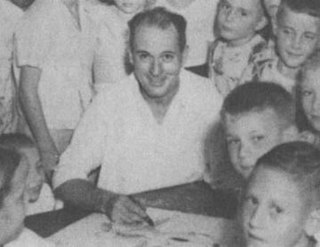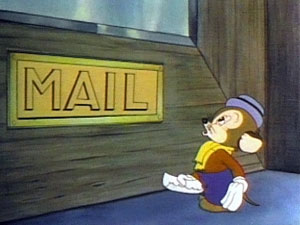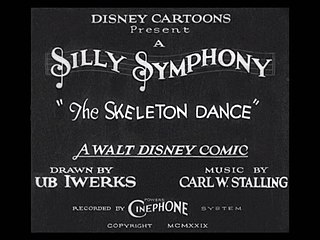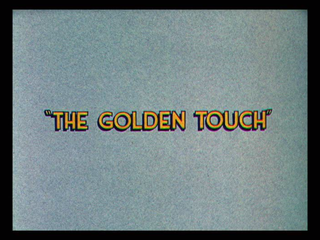
Ubbe Ert Iwerks, known as Ub Iwerks, was an American animator, cartoonist, character designer, inventor, and special effects technician, known for his work with Walt Disney Animation Studios in general, and for having worked on the development of the design of the character of Mickey Mouse, among others. Born in Kansas City, Missouri, Iwerks grew up with a contentious relationship with his father, who abandoned him as a child. Iwerks met fellow artist Walt Disney while working at a Kansas City art studio in 1919.

Charles Alfred "Al" Taliaferro, was an American Disney comics artist who produced Disney comic strips for King Features Syndicate. Taliaferro is best known for his work on the Donald Duck comic strip. Many of his strips were written by Bob Karp.
Silly Symphony is an American animated series of 75 musical short films produced by Walt Disney Productions from 1929 to 1939. As the series name implies, the Silly Symphonies were originally intended as whimsical accompaniments to pieces of music. As such, the films usually did not feature continuing characters, unlike the Mickey Mouse shorts produced by Disney at the same time. The series is notable for its innovation with Technicolor and the multiplane motion picture camera, as well as its introduction of the character Donald Duck making his first appearance in the Silly Symphony cartoon The Wise Little Hen in 1934. Seven shorts won the Academy Award for Best Animated Short Film.
The golden age of American animation was a period in the history of U.S. animation that began with the popularization of sound synchronized cartoons in 1928, began to decline around 1957, and ended by 1969, when theatrical animated shorts started to lose popularity to the newer medium of television. Animated media from after the Golden Age were produced on cheaper budgets and with more limited animation techniques by companies such as Terrytoons, UPA, Famous Studios, Jay Ward Productions, Hanna-Barbera, DePatie-Freleng Enterprises, Rankin/Bass and Filmation. In artefact, the history of animation became very important in the United States.

Sniffles is an animated cartoon and comic-book mouse character in the Warner Bros. Merrie Melodies and Looney Tunes series of cartoons and comics.
Burton F. Gillett was a director of animated films. He is noted for his Silly Symphonies work for Disney, particularly the 1932 short film Flowers and Trees and the 1933 short film Three Little Pigs, both of which were awarded the Academy Award for Best Animated Short Film and both of which were selected for inclusion in the National Film Registry.

The Skeleton Dance is a 1929 Silly Symphony animated short subject produced and directed by Walt Disney and animated by Ub Iwerks. In the film, four human skeletons dance and make music around a spooky graveyard—a modern film example of medieval European "danse macabre" imagery. It is the first entry in the Silly Symphony series. In 1993, to coincide with the opening of Mickey's Toontown in Disneyland, a shortened cover of the cartoon's music was arranged to be featured in the land's background ambiance. The short's copyright was renewed in 1957, and as a published work from 1929 it will enter the US public domain on January 1, 2025.

Three Little Pigs is a 1933 animated short film released by United Artists, produced by Walt Disney and directed by Burt Gillett. Based on the fable of the same name, the Silly Symphony won the 1934 Academy Award for Best Animated Short Film. The short cost $22,000 and grossed $250,000.
Don Towsley was an animator working at Walt Disney Animation Studios, and later at MGM and Filmation.
Elmer Elephant is a Silly Symphony cartoon short produced by The Walt Disney Company, directed by Wilfred Jackson and released on March 28, 1936.

The Tortoise and the Hare is an American animated short film part of the Silly Symphony series, released on January 5, 1935, by United Artists, produced by Walt Disney and directed by Wilfred Jackson. Based on an Aesop's fable of the same name, it won the 1934 Oscar for Best Short Subject: Cartoons. This cartoon is also believed to be one of the inspirations for Bugs Bunny by Warner Bros., who first appeared in 1940.

The Golden Touch is a Walt Disney Silly Symphony cartoon made in 1935. The story is based on the Greek myth of King Midas, albeit updated into a Medieval setting. It was the last film directed by Disney.

The Pied Piper is an American Pre-Code animated short film based on the story of the Pied Piper of Hamelin. The short was produced by Walt Disney Productions, directed by Wilfred Jackson, and released on September 16, 1933, as a part of the Silly Symphonies series.

The Grasshopper and the Ants is a 1934 American animated short film produced by Walt Disney Productions and released by United Artists. Part of the Silly Symphonies series, the film is an adaptation of The Ant and the Grasshopper, one of Aesop's Fables. It was directed by Wilfred Jackson and stars Pinto Colvig as the voice of the grasshopper Hop.

Three Blind Mouseketeers is a Silly Symphonies cartoon based on the nursery rhyme Three Blind Mice and the 1844 novel The Three Musketeers by Alexandre Dumas. Directed by Dave Hand and Jack Cutting, it stars Billy Bletcher.

The Flying Mouse is a Silly Symphonies cartoon produced by Walt Disney, directed by David Hand, and released to theatres by United Artists on July 14, 1934. The use of color here was rather innovative as it is set during the course of a single day.
Mother Goose Melodies is a 1931 Silly Symphonies animated film, directed by Burt Gillett. Two years later it was semi remade in Technicolor as Old King Cole.

Woodland Café is a Silly Symphonies animated Disney short film. It was filmed in Technicolor and released by United Artists in 1937 and was re-issued by RKO Radio Pictures in 1948. While it contained no on-screen credits, Wilfred Jackson was the director and Leigh Harline was the musical director.
Silly Symphony, initially titled Silly Symphonies, was a weekly Disney comic strip that debuted on January 10, 1932, as a topper for the Mickey Mouse strip's Sunday page. The strip featured adaptations of Walt Disney's popular short film series, Silly Symphony, which released 75 cartoons from 1929 to 1939, as well as other cartoons and animated films. The comic strip outlived its parent series by six years, ending on October 7, 1945.

Milton Mouse is an animated character created at Fables Studios for Paul Terry's cartoon series Aesop's Fables. The character was introduced in 1921, and appeared in dozens of cartoon shorts through 1931. Milton often appeared alongside a girlfriend mouse, usually named Rita.













